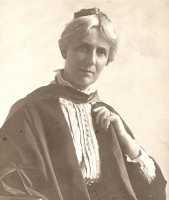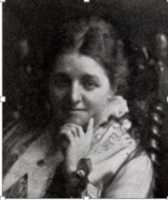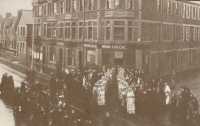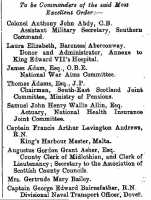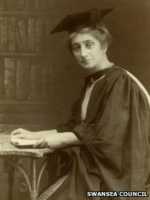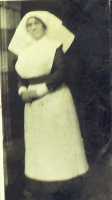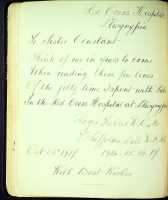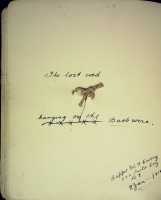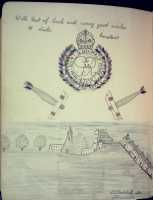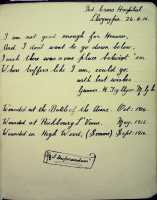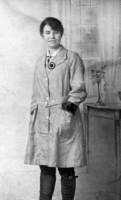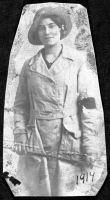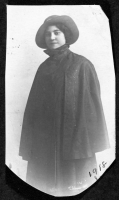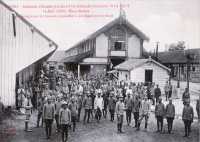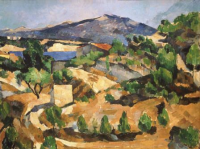Browse the collection
Sorted by date of death
Hester Millicent MacKenzie (née Hughes)
Place of birth: Bristol
Service: Educationalist, activist
Death: 1942, Brockweir, Cause not known
Notes: Born in 1863, Millicent MacKenzie was appointed associate Professor of Education (women) at the University College of South Wales and Monmouthshire (later Cardiff University) in 1904, and full Professor in 1910. She was the first women professor in Wales. She was a co-founder of the Cardiff and District Women’s Suffrage Society in 1908, which by 1914 was the largest outside London with 1200 members. Both before and during the War she was much involved the Girls’ Club of the University Settlement in Splott, Cardiff (where she met her husband, Prof J S Mackenzie). She stood, unsuccessfully as Labour Candidate for the Welsh universities’ seat in the 1918 election, the only woman to stand for a Welsh seat.
Sources: http://www.walesonline.co.uk/lifestyle/nostalgia/how-women-classes-came-together-12596684
Reference: WaW0246
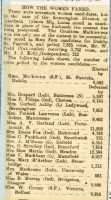
Newspaper report
Report on women candidates’ results in the 1918 General Election. Cambrian News and Merionethshire Standard 3rd January 1919.
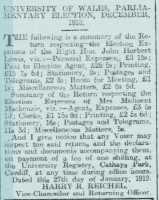
Newspaper report
Report on election expenses, University of Wales candidates. North Wales Chronicle 14th February 1919rn
Gertrude Mary Bailey (née Buchanan)
Place of birth: Sunderland
Service: Businesswoman, Committee woman, Grand Dame, 1914 - 1919
Death: 1942, Cause not known
Notes: Gertrude Bailey moved to Newport following her marriage to the wealthy Newport ship-repairer C H Bailey in 1895. Following his death in 1907 she continued to run his successful business. From the outbreak of War she became involved in many war-related activities, included help for Belgian Refugees and the Red Cross, and serving on the War Pensions committee. In 1917 Gertrude established a crèche for the children of women munitions workers. She received the CBE in 1918; curiously there is no citation with her name. Perhaps she was involved in too many things to list. In 1920 she handed over the business to her sons, and became one of Newport’s first two women magistrates. Gertrude was anti-suffrage before the War, and patron of temperance societies. Who’s Who in Newport (1920) described her as ‘La Grande Dame of the place’.
Sources: Sylvia Mason: Every Woman Remembered. Saronpublishers 2018\r\nhttp://www.newportpast.com/gallery/photos/php/search.php?search=munition&search2=&Submit=Submit
Reference: WaW0360
Lydia Elizabeth (Bessie) Jones
Place of birth: Llanfrothen
Service: Nurse, 1914/5 - 1919
Death: 1942, Cause not known
Notes: Bessie Jones (born 1872) was her forties when the War broke out. She came from a large middleclass family, was involved in the community (she was a Lady Visitor at Penrhyndeudraeth Workhouse) and followed her father’s pack of otter hounds. Early in the War she joined the French Red Cross, and served with them until 1919. In the latter stages of the War she worked as an anaesthetist working long hours under bombardment and her hospital was damaged by shrapnel. She also witnessed an early blood transfusion. She wrote long letters to her sister Minnie Jones [qv], some of which were published in the local press. She also wrote some articles that were published in Welsh Outlook including Dawn in a French Hospital (October 1916) using the pseudonym Merch o’r Ynys. Her final posting was in Strasbourg; she returned home in August 1919. She was awarded the Croix de Guerre for her work in the Champagne region of France, and also the Military Medal. Bessie seems to have been fluent in English, Welsh and French, as well as being an accomplished pianist.
Reference: WaW0440
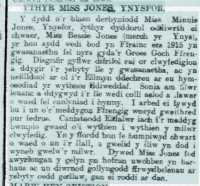
Newspaper letter
Letter to Bessie’s sister Minnie Jones describing a blood transfusion. Yr Herald Cymraeg 2nd April 1918.
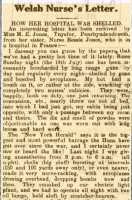
Newspaper letter
Letter to Bessie’s sister Minnie Jones describing life in a field hospital under bombardment, and being suspected of being a spy, Cambrian News 16th August 1918 1.
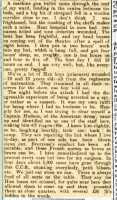
Newspaper letter
Letter to Bessie’s sister Minnie Jones describing life in a field hospital under bombardment, and being suspected of being a spy, Cambrian News 16th August 1918.
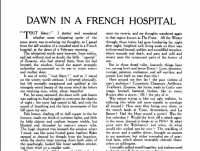
Welsh Outlook
Beginning of Bessie Jones’s (Merch o’r Ynys) essay ‘Dawn in a French Hospital’. Welsh Outlook Vol 3 No 10 October 1916.
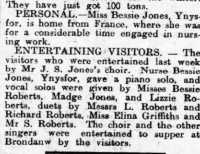
Newspaper report
Report of Bessie Jones’s return from France, and her performance in a concert. North Wales Chronicle 29th August 1919.
Emily Frost Phipps
Place of birth: Devonport
Service: Teacher, activist, barrister
Death: 1943, Heart disease / Clefyd y galon
Notes: Born November 1865 and the daughter of a dockyard coppersmith, Emily Phipps worked her way from pupil teacher to headmistress of Swansea Municipal Girls’ School in 1895. She was an active feminist, boycotting the 1911 census with her partner Clara Neal (and three others, staying in a sea-cave overnight), was President of the National Union of Women Teachers 1915, 1916 and 1917, and was the editor of the Union journal. She promoted professional careers for girls, shocking some in March 1914 by suggesting that they could become dentists. Emily Phipps stood for Parliament, for Chelsea, in the 1918 election, one of only two women in Wales to stand. She later studied for the bar, and became a barrister in 1925.
Sources: https://en.wikipedia.org/wiki/Emily_Frost_Phipps
Reference: WaW0247

Newspaper headline
Headline to report of Emily Phipps’s speech at Municipal Secondary Schools Prizegiving, 20th March 1914. Cambrian Daily Leader 21st March 1914rnrn

Newspaper report
Report on women candidates’ results in the 1918 General Election. Cambrian News and Merionethshire Standard 3rd January 1919.rn
Margaret Ker Pryse-Rice (Stewart)
Place of birth: Cardiganshire
Service: Red Cross president, Brisitsh Red Cross Society
Death: 1948, Cause not known
Notes: Margaret Pryse-Rice was the mother of Dorothea and Nest. She was President of the Carmarthenshire Branch of the British Red Cross Society and was made a Dame of the British Empire in the New Year Honours of 1918. She died in 1948, aged 72.
Reference: WaW0205
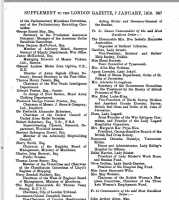
London Gazette 7th January 1918
London Gazette 7th January 1918, showing the name of Margaret Pryse-Rice
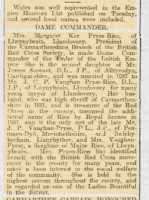
Newspaper report
Report of Margaret Pryse-Rice’s honour in the Carmarthen Journal. The Cambrian News reported it too, but only mentioned her husband’s achievements!
Sally Constant
Place of birth: Rhondda
Service: Nurse (Sister), 1914 - 1918
Death: 1949, Cause not known
Notes: Sister Sally Constant nursed at Llwynypia Hospital, Rhondda, throughout the War. She may have trained in Cardiff before the War. Like many nurses, she had an album (dating back to 1907), which includes many entries from soldier patients. She worked up until WW2.
Reference: WaW0148
Lilias Stuart Mitchell (née Wilsone)
Place of birth: Straights Settlement
Service: Committee woman, mother.
Death: 1949, Kent, Cause not known
Notes: Lilias Mitchell was the wife of A A Mitchell, Alderman and JP in Brecon, and mother of Isabella Mitchell [qv] who drove ambulances in France. Her elder son was killed in Mesopotamia in 1917, and her younger son seriously wounded in France in 1918. She and her husband were noted local Conservatives; Lilias supported refugees and Penoyre Red Cross Hospital. She was also Secretary of the Brecon Hiring Fair Committee and was a member of the Mental Deficiency Act Committee. In June 1918 She was awarded the Medaille de la Reine Elisabeth for her work with Belgian refugees. She and her husband left the area in 1919.
Reference: WaW0396

Newspaper report
Report of Mrs Mitchell’s appointment to the Mental Deficiency Act Committee. Brecon County Times 5th August 1915.
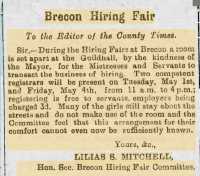
Newspaper letter
Letter to the newspaper about provisions for girls at the Brecon Hiring Fair. Brecon County Times 26th April 1917.
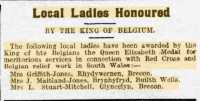
Newspaper report
Report of Mrs Mitchell’s award of the Medaille de la Reine Elisabeth. Brecon & Radnor Express 27th June 1918.

Notice of auction
List of garden and stable items sold by the Mitchells before their departure from Brecon. Brecon County Times 21st August 1919.
Catherine Meriel (Alcy) Howard (Lady) (née Cowell-Stepney)
Place of birth: London
Service: Philanthropist, committee women, local councillor
Death: 1952, Llanelli, Cause not known
Notes: Lady Howard, born 1876, was the second wife of Edward Stafford Howard, a former Liberal politician and Llanelli benefactor. He was 25 years older than her, and died during his mayoralty of Llanelli in 1916. Lady Howard, who was already an active member of the Board of Guardians (which she later chaired), was co-opted as an alderman to complete his term as mayor. She was subsequently, 1919, elected to the council. She was a strong supporter of the YWCA, and President of the Llanelly Women’s Liberal Association. She was awarded an MBE in 1918, when the Cambrian Daily Leader wrote: ‘No department of war work, no movement for the betterment of the people in Llanelly is complete without her..’. After the war she became a County Councillor and a JP (1920).
Reference: WaW0284
![Newspaper report Report of Lady Howard’s co-option as Mayor of Llanelly [sic]. Cambrian Daily Leader 17th May 1916.Report of Lady Howard’s co-option as Mayor of Llanelly [sic]. Cambrian Daily Leader 17th May 1916.](lluniau/cambrian_daily_leader_17th_may_1916_bawd.jpg)
Newspaper report
Report of Lady Howard’s co-option as Mayor of Llanelly [sic]. Cambrian Daily Leader 17th May 1916.Report of Lady Howard’s co-option as Mayor of Llanelly [sic]. Cambrian Daily Leader 17th May 1916.
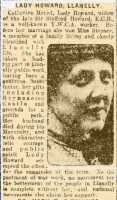
Newspaper report and photograph
Report of Lady Howard’s award of MBE. Cambrian Daily Leader 12th June 1918.

Newspaper report
First part of report of a meeting of the poor law guardians, chaired by Lady Howard. The guardians, supported by Lady Howard, were complaining about the inadequacy of the new workhouse diet. Llanelly Star 10th August 1918, p 3.
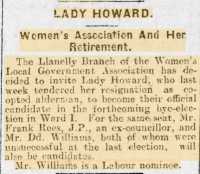
Newspaper report
Report of Lady Howard standing for election in the local elections of 1919. She had previously been co-opted, but had a strong belief in a proper ballot. Cambrian Daily Leader 17th November 1919
Gladys May Evans
Place of birth: Margam/Port Talbot ?
Service: Gardener, Womens Land Army
Death: 1952, Cause not known
Notes: Gladys, born 1898, worked in the gardens of St Fagan’s Castle. The castle itself was a war hospital, and the gardens supplied the kitchens. There are several photographs of Gladys; perhaps they were for publicity purposes.
Reference: WaW0449
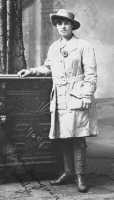
Gladys May Evans
Gladys May Evans in WLA uniform, possibly taken in St Fagans Castle. The badge represents ‘two months approved service’.
Gwendoline Elizabeth Davies
Place of birth: Llandinam
Service: Collector, philanthropist, canteen worker, French Red Cross, 1916 - 1918
Death: 1952/07/03, Leukaemia /Lewcemia
Notes: Gwendoline, born 1882, was the elder granddaughter of David Davies the coal owner and builder of Barry Docks. She, her sister Margaret [qv] and her brother David each received one third of his vast fortune on the death of their father in 1898. All three were strict Calvinistic Methodists, with a strong philanthropic streak. The two sisters began to travel widely, and to study art in Europe. In their early twenties they were beginning to form the collection that is now at the National Museum Wales. In March 1913 the collection was exhibited, anonymously, in Cardiff; the sisters covering all of the cost. It attracted 26000 visitors. At the outbreak of war the sisters promoted a scheme to invite Belgian artists and musicians to come to Wales, settling them in Aberystwyth and Llanidloes [see De Saedeleer]. In 1916, following the death of her cousin in the Dardanelles, Gwen volunteered to join the French Red Cross, leaving in July to open a Cantine des Dames Anglaises where she remained until the end of the war. The Cantine was moved in 1917 to Troyes, where her sister joined her. Gwen’s job as Directrice meant visits to headquarters in Paris, which in turn enabled her to add pictures, including two Cézannes, to her collection. In early 1918 her collections in Paris were at risk from air-raids and long distance shelling, so it was arranged for them to be shipped back to Britain. By 1922 she had given up collecting art. She felt she could not spend money in this way ‘in the face of appalling need everywhere’. During the 1920s Gwendoline set up a centre for the arts at Gregynog near Llandinam, promoting art in the cause of peace and social progress. She continued to give generously to educational and other causes. On her death in 1951 she bequeathed her remarkable collection of paintings and sculpture to the National Museum of Wales.
Sources: Oliver Fairclough [ed] Things of Beauty: What two sisters did for Wales. National Museum Wales 2007. Trevor Fishlock A Gift of Sunlight. Gomer 2014\r\nhttps://museum.wales/articles/2007-07-29/The-Davies-Sisters-during-the-First-World-War/
Reference: WaW0333

Oprning of the Ocean Coal Company pithead baths
Gwendoline Davies (centre) and Margaret (left) at the opening of the first pithead baths in Wales, summer 1916. This was shortly before she left for France.
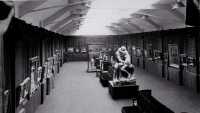
Loan exhibition 1913
Loan exhibition of the Davies sisters’ collection in City Hall, Cardiff, February 1913. It includes Rodin’s The Kiss, bought by Gwendoline in 1912.

